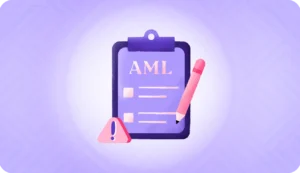Art & money laundering have a romantic relationship dating back to the eighteenth century. Since then, art has been used as an effective means of laundering money by criminals seeking to avoid detection and prosecution. Art is a particularly attractive medium for money launderers because it can be acquired and sold anonymously, with transactions often conducted internationally.
The Art Money Laundering Chain
The art money laundering chain is a series of steps criminals take to launder their illegal proceeds successfully. The international art market has recently seen a rapid expansion at a Compounded Annual Growth Rate (CAGR) of 62%, with a market size of over 448 billion in 2022. This high demand for artwork offers criminals opportunities to hide the proceeds of their crimes and make them untraceable.
Money laundering through art involves concealing illegal or dirty money by buying valuable items such as paintings, sculptures, jewelry, or antiques and then selling them later for a profit. This buying and selling process is repeated until the money has been sufficiently laundered, making it virtually untraceable to its source.
Art Anti-Money Laundering Indicators
No single set of rules applies to every transaction in this space. Still, certain commonalities can be used as indicators when attempting to spot potential cases of money laundering through art.
One key characteristic of art-related money laundering is using shell companies or other third parties. These entities often mask ultimate beneficial ownership and make it more difficult to track the true source of funds.
Additionally, art collectors and dealers should be aware of common practices such as ‘flipping’, when an individual buys a piece of artwork for a low price and then quickly resells it for a higher one.
Art Money Laundering Regulations
As art transactions become ever more globalized, so have regulations designed to prevent money laundering in this space. Countries worldwide have begun implementing anti-money laundering (AML) regulations that require art dealers and other intermediaries to conduct due diligence on buyers and sellers.
United States
The Anti-Money Laundering Act of 2020 (AMLA 2020) is a federal law that requires dealers and other intermediaries to conduct due diligence on buyers and sellers. Under the act, they must verify the source of any funds used to purchase artwork. Moreover, parties purchasing the art must verify the owners, maintain appropriate records, and implement robust compliance policies and procedures.
Europe
The European Union’s Fifth Anti-Money Laundering Directive (5AMLD) also introduces due diligence measures for art transactions. Under the directive, art dealers must have sufficient knowledge of their customers and conduct appropriate risk-based due diligence.
The Sixth Anti-Money Laundering Directive (6AMLD) is the successor to the 5AMLD and is regarded as one of the toughest AML regimes in the world. It strengthens existing measures to make it more difficult for criminals to launder money through art transactions. It has made AML and Customer Due Diligence (CDD) obligatory for all stakeholders involved in buying and selling art. Moreover, the penalties for failing to comply with these regulations have increased significantly.
Famous Art Money Laundering Examples
The two most famous art money laundering examples are:
- Financing of the movie Wolf of Wall Street
- The 2013 blockbuster was in part funded by a money laundering scheme. Najib Rajak, the Malaysian Prime Minister, used money from the Malaysian sovereign fund to produce the movie.
- Brazilian economist and banker Edemar Cid Ferreira bought dozens of paintings of famous artists as a way to hide his dirty money and convert it into legal money.
Steps To Protect Your Business Against Money Laundering Through Art
There are several measures businesses can take to protect themselves from money laundering. First and foremost, they should conduct thorough due diligence on all their customers. This means verifying the source of funds used to purchase artwork and ensuring that the customer is not associated with any criminal activities.
Secondly, they should red flag any suspicious transactions or behavior patterns that may indicate money laundering. If a customer attempts to flip a piece of artwork by buying and selling it quickly, this should be reported to the relevant authorities. Additionally, they should maintain detailed records of all their transactions, which can help with investigations and prosecutions should a money laundering case be uncovered.
Finally, they can also take the help of technology. This includes implementing advanced AI tools for KYC verification, AML detection, and fraud prevention. These tools help verify the customer’s identity and check for potential money laundering activities. They can also detect anomalies in transactions that may indicate fraudulent activities.
HyperVerge offers online identity verification, KYC/AML checks, and fraud prevention solutions that help safeguard businesses from money laundering. Our solutions are fast, secure, and compliant with all applicable laws and regulations.
FAQs
What is anti-money laundering (AML)?
AML is a set of laws and regulations designed to prevent criminals from laundering money through legitimate financial institutions.
What is the Fifth Anti-Money Laundering Directive (5AMLD)?
5AMLD was introduced by the European Union in 2018 and requires art dealers to have sufficient knowledge of their customers and conduct appropriate due diligence when dealing with them.
What is KYC?
KYC stands for Know Your Customer and is a customer identification and verification process. It helps ensure that businesses deal with legitimate customers, not criminals.





